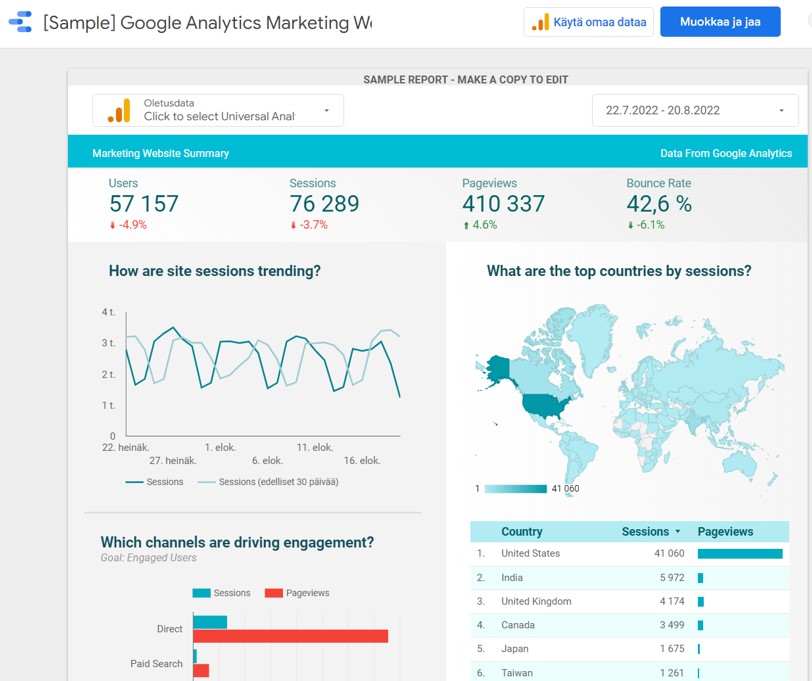
Web analytics for profitable business development
1 Sep 2022
What is web analytics?
Web analytics is the study of measurable data from a website in order to understand and develop the service to better meet your intended needs.
Web analytics is an essential tool for effective digital business development. Measurement combined with active development are common ways to improve results in any activity, but digitalisation usually allows for more accurate measurement.
For example, e-commerce combines digital and traditional measurement: the logistics of physical products usually require several human actions along the way, but the tracking of visitors on the shopping platform can be fully automated.
The benefits of web analytics are undeniable
Digital measurement offers easily understandable advantages over human measurement: accuracy, speed, completeness and precision. It is also quick and straightforward to start collecting basic measurement data. To top it all off, proper measurement and development moves business metrics in a better direction: more leads, online purchases, better brand awareness, smoother online transactions, and so on.
Through web analytics you can for example improve the profitability of your business and increase your turnover.
In general, if your organisation has any kind of web service on the public internet, it is worth installing at least basic-level web analytics. Even if you are not actively developing your web service at the moment, you will collect valuable information about visitor behaviour, which will be presented by the software in the form of various reports. In this way, you will have a solid basis for later active development based on the collected data.
How do I know if my company’s web analytics are in order?
While the adoption of web analytics is rapid and the benefits undeniable, surprisingly few organisations have invested much in it. What’s more, many companies are unpleasantly surprised to find that things are worse than they imagined.
That’s why we developed a simple template to give you an indication of the level of measurement in your organisation. The intention is not to give an all-encompassing description of the potential for utilisation, but to set out as concrete and understandable a formula as possible for using web analytics in your organisation.
Please note that the use of web analytics is service-specific. In other words, even if one web service is being developed in a very data-driven way, another may lack a basic web analytics setup altogether. The model below is therefore worth considering for each relevant web service in your organisation.
Level 0. Refuser
This level usually refers to how the organisation generally views the culture of measurement. If business measurement is not generally perceived as necessary, it is likely that the same will be true for digital services. Since public online services are usually produced by companies for a reason, there is little logical justification for excluding measurement. Conversely, if the online service is of little or no relevance, it is hardly worth investing resources in web analytics.
Level 1. Beginner
It is typical for a beginner that measurement is valued but relies on the expertise of external suppliers. We strongly recommend gaining a basic understanding among your organisation. This can be done either by self-study (say by reading this article) or by buying basic coaching from a professional. This investment in mapping your understanding usually pays for itself very quickly.
Indeed, in our experience, it is not at all uncommon that, even if a basic web analytics setup has been done at the launch of a web service, no data has been collected. So the first thing we recommend is to log into the admin view of your web analytics tool and verify with your own eyes that data is being collected.
Then make sure that your analytics account is owned by your organisation. Doing things the right way means that your suppliers are given access to your company’s account and not the other way around. You don’t want your valuable data to be owned by someone else, do you?
So you lay the foundations for data-driven development with the following simple formula:
- Gain understanding. Get a basic understanding of the subject.
- Check that your company owns the service’s analytics account and data is being collected.
- Experiment. Review analytics software reports and consider trends.
With very little effort and investment, you can build the foundation for using web analytics in your organization. Google Analytics, for example, is free and has established itself as a de facto tool, usually installed automatically on a web site during implementation.
At a minimum level, a public web service should have a purpose.
Level 2. Utilizer
This may be the most common level across all types of organisations. At the launch of the web service, basic web analytics are connected and data capture is ensured. It is typical of this level that data-driven development is not yet very systematic or continuous.
We recommend at least this level for all goal-oriented organisations.
Exploitation starts with building a data-driven culture in the organisation. You can start developing a culture with small steps. One way is to adopt a systematic approach to viewing measurement data in analytics tools’ own reporting dashboards. For example, once a quarter is already a good starting point and once a month provides an adequate scope for review for most online services.
Once the review has become a systematic part of the company culture, consider automated reporting at the desired interval. Google Data Studio, for example, offers an easy way to automate reporting at, say, a monthly or weekly level.

As you can see from the example image, the basic set-up of the tool is very straightforward if you already have Google Analytics data connected to your online service. Just select the default data source from the drop-down menu in the top left corner and you’ll immediately see a sample visualisation of your own data.
Naturally, a Data Studio report tailored to a specific business objective requires a little tweaking, but you can get it from a professional. It’s a one-time effort and after that the analytics tracking becomes more convenient and you can automatically share the report, for example by email, with the desired people in your organisation.
Once the culture of the organisation has been made more data-driven and analytics reports are regularly reviewed at the desired interval, the next step is to analyse the data and create a development action list. Data will only become useful if decisions or actions are taken based on it.
Level 3. Advanced
At the advanced level, data is built into the DNA of the organisation. It goes without saying that before making decisions or taking development measures, you want to look at actual visitor behaviour through data. An advanced data utiliser has a culture of regular measurement and development and web analytics is perceived as one of the most important aspects of further development of the web service to ensure that business objectives are met.
An advanced level data utiliser is able to explain the concrete and measurable benefits that the use of web analytics brings to their business.
Aiming for the top tier is recommended for any growth-oriented company that has a public online service harnessed for business purposes. A typical example is an online shop, a website or a customised web application. For online retailers, the use of analytics is usually straightforward, as conversion optimisation, for example, directly generates more sales. For websites, on the other hand, there is still an alarming lack of attention.
For web applications, analytics may be completely absent, as tools such as those required for search engine optimisation may have to be manually built. On the other hand, customised software may also make use of slightly different types of analytical tools, for example to improve the performance of the software.
Some practical tips to get to this level:
- Be consistent. Measurement has become commonplace, even self-evident. Data is always sought to support decisions and development. If it’s not there, you wonder where to get it.
- Understand. Find out what types of development activities the company can do itself and what makes most sense to buy from outside. Typical examples include search engine optimisation, search engine marketing, software development, conversion optimisation, user experience improvement, service design or content production.
- Implement. An advanced web analytics utiliser understands that the benefits of measurement can only be seen below the bottom line through action.
In many companies, reaching this level is enough to squeeze out significant business benefits. It is motivating that achieving this level does not require huge investments, expensive specialised tools or a large company size, it is more a question of attitude, prioritisation and systematisation.
Level 4. Pioneer
A pioneer’s goal is simply to use web analytics to drive business development in a way that generates maximum growth. Pioneering requires a strong culture of experimentation and economies of speed. A pioneer uses a wide range of software to measure and interpret their data. A skilled growth hacker is often at the pioneer level, applying a variety of tools to generate growth.
Becoming a pioneer requires learning by doing. In other words, if an organisation wants to get the most out of data, it needs a compatible culture of measurement and experimentation, a creative understanding and use of analytics tools, and the courage and willingness to grow faster than others.

Would you like to become more data-driven?
Need help getting started with measuring? Or are you already well underway with data-driven development, but need an expert in a particular area? Our multi-skilled team of experts can help you get value from measurement in your business.
What does web analytics measure?
Visitor tracking is the most familiar aspect of web analytics
Visitors to various online services (e.g. cloud computing products) and websites (the digital footprint of a company) can be studied using visitor tracking. Visitor tracking can be used to view, for example:
- Where visitors to the site come from, i.e. the source that has directed them to the site
- How long is the time spent on the page
- How many page loads are made
- How visitors interact with the site and what pages are browsed
- What is searched internally on the page
- Whether the desired actions are being done
Studying visitors’ behaviour provides useful and sometimes surprising information about who is visiting the site and what they are doing there. Direct visitor tracking was still practiced a decade ago with a variety of tools, including the open source Awstats software.
However, the development of analytics tools has been so rapid that today Google Analytics is established as the de facto solution for visitor tracking. Google Analytics is free, it is constantly evolving and is available in most countries. Google’s search engine is the most interesting from a visitor tracking perspective. Of course, it is more than just a visitor tracking tool, but there is a dashboard for that too.
However, tracking website visitors is only part of the data that is usually required to achieve business objectives.
Web analytics is much more than that
Web analytics can be used to study and analyse the performance of an entire web service from several different perspectives. The main role of web analytics is to enable the measurement and development of pages to achieve optimal performance in terms of business objectives.
In addition to visitor tracking, web analytics can be used to identify, measure and develop, among other things:
- Improve the functionality of the web service
- Identify problem areas and bottlenecks
- Improve findability and search visibility
- Optimise digital advertising
- Increase sales and the quantity and quality of leads
- Ensure the user-friendliness of the website
- Increase the relevancy of content
- Discover new business opportunities
Web analytics is a versatile way to improve your website so that it serves your overall business goals.
Best results from web analytics are gained with persistency
Like any business, online business should be developed and measured systematically, whether it is an online shop, a customised software, or a website. Leveraging web analytics starts with learning how to install analytics correctly. The installation of analytics can be done quickly as a one-off exercise or in a very comprehensive and precise manner at the desired points. The latter requires better business planning and more installation work, but the investment pays off with interest over time because the data is more accurate and tailored to the need, making development easier.
In simple terms, a basic analytics setup provides general useful metrics for any online service, while a more comprehensive setup better addresses business and service-specific needs. One of the key functions of website analytics is to provide data that can be used to determine whether a web service is meeting its objectives. These objectives are commonly referred to as Key Performance Indicators (KPIs).
Once these indicators have been defined and installed on the website, the website and its users can be analysed effectively and monitored to see if the objectives are being met. KPIs can also be used to measure and improve digital advertising and ensure its effectiveness.
Google Analytics 4 and web analytics
Google Analytics is so well established in the market that it is difficult to talk about web analytics without it. Usually, public websites have Google Analytics installed as standard, regardless of whether there is an intended use for it. The use of Google Analytics is logical, as most companies aim to gain visibility in Google search results. In addition, advanced analytics tools take input data from a number of sources, of which Google Analytics is one of the most common.
The popular analytics tool is currently undergoing a generation change to Google Analytics 4 (GA4). One of the promises of Google Analytics 4 is to extend the tool from web services to applications. The integration and management of different channels is familiar from many other areas of digital business development (e.g. e-commerce and multichannel). It remains to be seen how the role of Google Analytics will evolve in the future in terms of version updates and data privacy issues.
Alternatives to Google Analytics
While Google Analytics has become almost synonymous with web analytics, there are a significant number of other tools on the market, each with their own strengths. It is noteworthy that several tools request access to Google Analytics data and add additional useful tools on top of it. Below is a list of some commonly used tools that can be used for a wide range of web development, but which may have slightly different areas of focus. Web analytics professionals typically use several different tools in a fluent manner depending on the development need, application focus, and business goals.
A few popular analytics tools:
- Amplitude
- Mixpanel
- Semrush
- Heap
- Adobe Analytics
- Piwik
- Matomo
- Chartbeat
There are so many good options for different analytics needs and the pace of development is so fast that it is pointless to try to rank the tools. Each tool has its own approach and fan base, experimentation will reveal the best one for your needs.
Shortcuts
- What is web analytics?
- The benefits of web analytics are undeniable
- How do I know if my company's web analytics are in order?
- Level 0. Refuser
- Level 1. Beginner
- Level 2. Utilizer
- Level 3. Advanced
- Level 4. Pioneer
- Would you like to become more data-driven?
- What does web analytics measure?
- Web analytics is much more than that
- Best results from web analytics are gained with persistency
- Google Analytics 4 and web analytics
- Alternatives to Google Analytics




